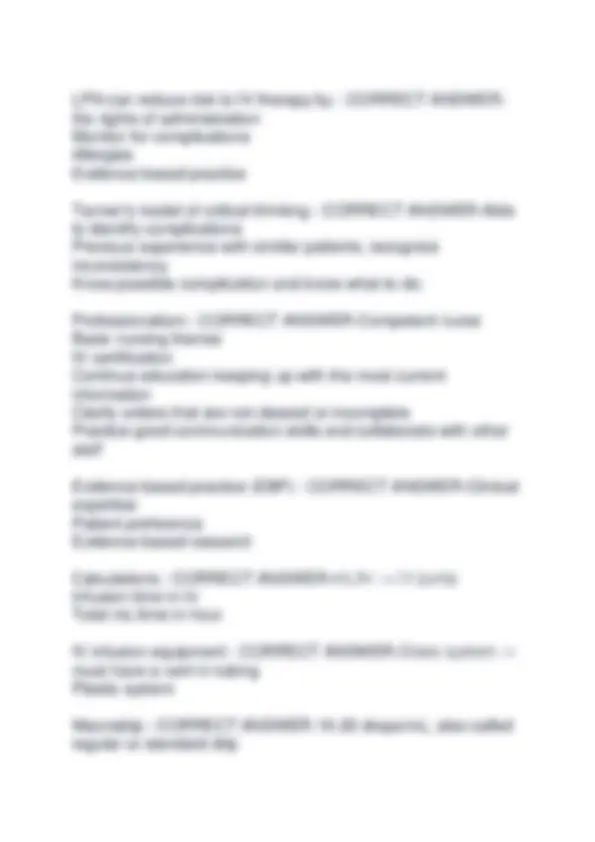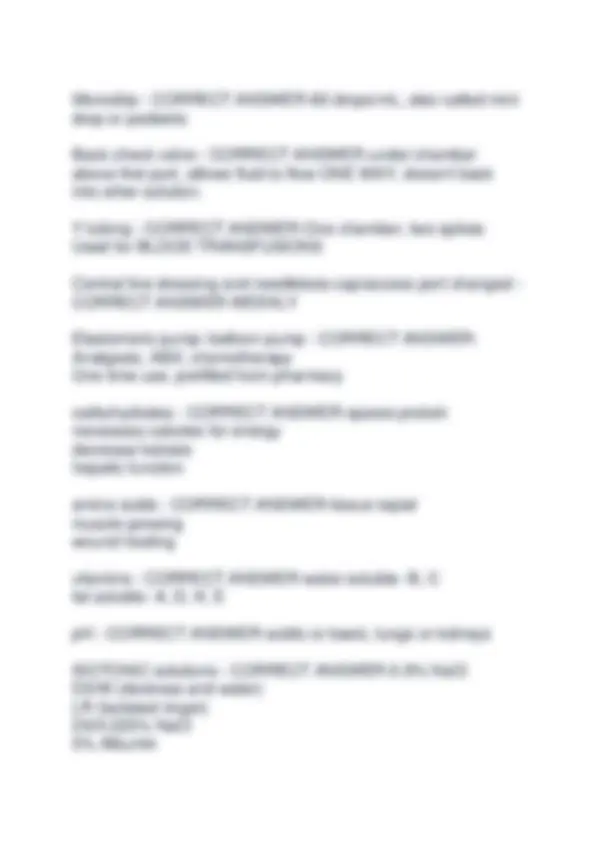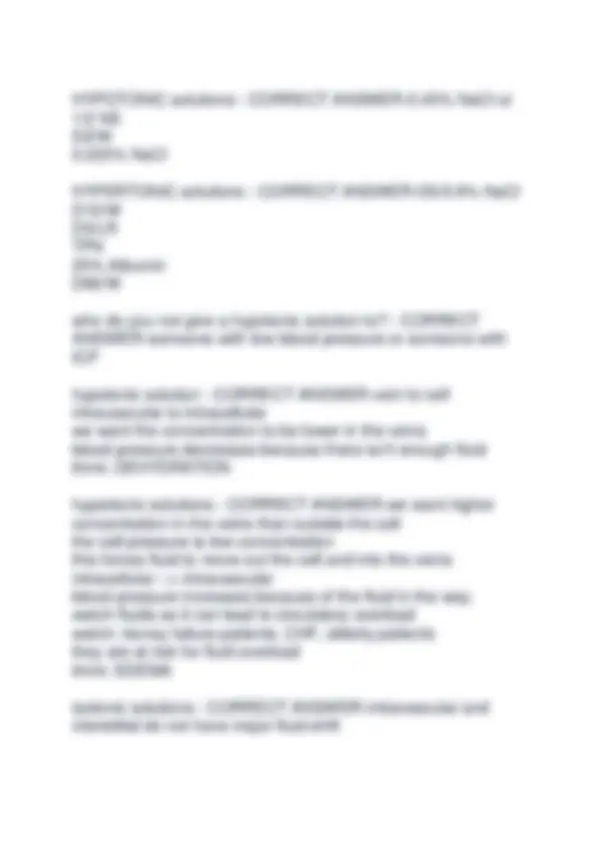





Study with the several resources on Docsity

Earn points by helping other students or get them with a premium plan


Prepare for your exams
Study with the several resources on Docsity

Earn points to download
Earn points by helping other students or get them with a premium plan
Community
Ask the community for help and clear up your study doubts
Discover the best universities in your country according to Docsity users
Free resources
Download our free guides on studying techniques, anxiety management strategies, and thesis advice from Docsity tutors
A comprehensive overview of key concepts in healthcare law and iv therapy, relevant for nursing students. It covers topics such as scope of practice, consent, advanced directives, malpractice, standards of care, patient safety goals, informed consent, unusual occurrence reports, sentinel events, code of ethics, iv therapy procedures, just culture, patient self-determination act, tanner's model of critical thinking, professionalism, evidence-based practice, iv infusion equipment, and fluid types. Questions and answers, making it a valuable resource for exam preparation and understanding these essential nursing concepts.
Typology: Exams
1 / 6

This page cannot be seen from the preview
Don't miss anything!




health care law - CORRECT ANSWER-Scope of practice Public health/infection control Consent Advanced directives Malpractice - CORRECT ANSWER-Type of negligence, any professional misconduct, unreasonable lack of professional skill, non adherence 4 elements of malpractice - CORRECT ANSWER-Duty Breach of duty Injury Causation Standards of care - CORRECT ANSWER-focuses on the recipient of care, patient Standards of practice - CORRECT ANSWER-focuses on the provider. National patient safety goals - CORRECT ANSWER-Identify patient correctly (name and DOB) Use medications safely (rights) Prevent infections Improve staff communication Identify patient safety risk to suicide Prevent mistakes in surgery
Informed consent - CORRECT ANSWER-Provide patient with enough information so they are able to make a decision. Nurse can be a witness, make sure it's signed. Dr is responsible to obtain consent Unusual occurrence report → incident report - CORRECT ANSWER-Non Judgemental, factual, not part of legal record. Sentinel event - CORRECT ANSWER-Not related to patient's natural course of illness (delay in treatment, pt fall, tissue necrosis) severe infiltrate. *malpractice complication with sentinel event. Injury causing a graft to patients IV site. Code of ethics - CORRECT ANSWER-The principles that used in ethical and moral decision making Scope of practice for IV therapy - CORRECT ANSWER-OBN Antibiotic = anti infection = antifungal Initiate (first dose) Maintain (administer/regulate) IVPB = secondary = intermittent infusion (IV piggy back) TPN PCA PICC Places where LPN can start an IV→ antecubital to hand Just culture - CORRECT ANSWER-Reporting healthcare errors without punishment. Nurse still to be held accountable for actions! Emphasis on correcting flows in the system and preventing future errors. Empowers staff to participate in reporting errors without fear of punishment. Nurse's legal, ethical and professional responsibility to participate to report error. Patient self determination act - CORRECT ANSWER-Health care law that gives patients the right to choose if they want to have the procedure done even if recommended by the doctor.
Microdrip - CORRECT ANSWER-60 drops/mL, also called mini drop or pediatric Back check valve - CORRECT ANSWER-under chamber above first port, allows fluid to flow ONE WAY, doesn't back into other solution. Y tubing - CORRECT ANSWER-One chamber, two spikes Used for BLOOD TRANSFUSIONS Central line dressing and needleless cap/access port changed - CORRECT ANSWER-WEEKLY Elastomeric pump: balloon pump - CORRECT ANSWER- Analgesic, ABX, chemotherapy One time use, prefilled from pharmacy carbohydrates - CORRECT ANSWER-spares protein necessary calories for energy decrease ketosis hepatic function amino acids - CORRECT ANSWER-tissue repair muscle growing wound healing vitamins - CORRECT ANSWER-water soluble- B, C fat soluble- A, D, K, E pH - CORRECT ANSWER-acidic or basic, lungs or kidneys ISOTONIC solutions - CORRECT ANSWER-0.9% NaCl D5/W (dextrose and water) LR (lactated ringer) D5/0.225% NaCl 5% Albumin
HYPOTONIC solutions - CORRECT ANSWER-0.45% NaCl or 1/2 NS D2/W 0.225% NaCl HYPERTONIC solutions - CORRECT ANSWER-D5/0.9% NaCl D10/W D5/LR TPN 25% Albumin D60/W who do you not give a hypotonic solution to? - CORRECT ANSWER-someone with low blood pressure or someone with ICP hypotonic solution - CORRECT ANSWER-vein to cell intravascular to intracellular we want the concentration to be lower in the veins blood pressure decreases because there isn't enough fluid think: DEHYDRATION hypertonic solutions - CORRECT ANSWER-we want higher concentration in the veins than outside the cell the cell pressure is low concentration this forces fluid to move out the cell and into the veins intracellular --> intravascular blood pressure increases because of the fluid in the way. watch fluids as it can lead to circulatory overload watch: kicney failure patients, CHF, elderly patients they are at risk for fluid overload think: EDEMA isotonic solutions - CORRECT ANSWER-intravascular and interstitial do not have major fluid shift